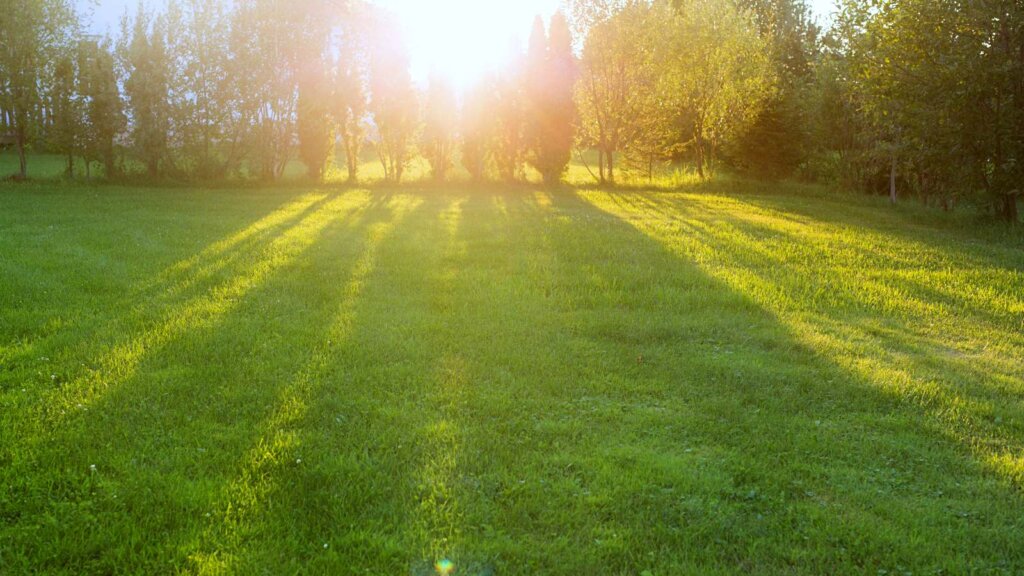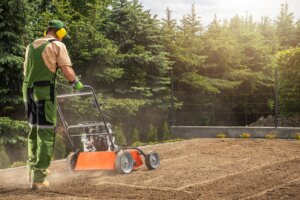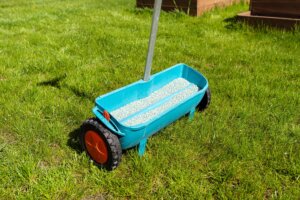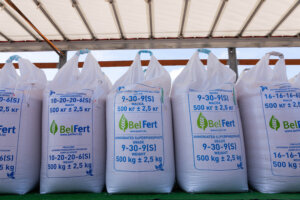For cool-season grasses like Kentucky bluegrass, tall fescue, and perennial ryegrass, apply fall lawn fertilizer twice:
• Early fall – Around Labor Day (late August to mid-September) with a high-nitrogen blend to promote root growth after summer heat.
• Late fall – Between late October and early November, about one to two weeks before the first frost, with a nitrogen-and-potassium-rich mix to store energy for winter dormancy and jumpstart spring green-up.
Water in the fertilizer after applying and avoid exceeding 1 pound of nitrogen per 1,000 sq. ft. in a single application.
Benefits of Fall Fertilizer

Fall lawn fertilization is one of the most important steps in yearly lawn care. While spring feeding boosts color, fall fertilizer for grass strengthens the foundation — the root system — so your yard can thrive year-round. A well-timed application:
- Builds stronger grass roots for better nutrient and water uptake
- Improves winter hardiness and disease resistance during colder months
- Encourages an early spring green-up without excessive blade growth
- Helps the lawn recover from the stress of summer heat and foot traffic
Essential Nutrients for a Beautiful Lawn
The best fall fertilizer contains three main nutrients — nitrogen, phosphorus, and potassium. Together, they act as complete lawn food:
- Nitrogen supports blade growth and energy storage for winter
- Phosphorus aids root development, especially important if you’re applying a starter fertilizer for new grass seed
- Potassium improves cold tolerance and overall lawn health
Cool-season grasses use about 70–75% of their annual nitrogen during fall, making it the most critical time for balanced feeding.
Early Fall Application (Late August–Mid-September)
University turf research recommends applying about two-thirds of your yearly nitrogen between mid-August and mid-September when soil is warm and roots are actively growing. Apply about two-thirds of your yearly nitrogen now to strengthen roots and prepare your lawn for the colder months.
If you’re overseeding, this is the time to apply a starter fertilizer high in phosphorus to give new grass seed an extra boost. Always follow directions on the product label to avoid overapplying.
Late Fall Application (Late October–Early November)
Your second feeding comes after blade growth slows but before the soil freezes. Turf sciences show that a nitrogen-and-potassium blend in late fall boosts root strength and spring green-up while improving winter hardiness. This final step in fall lawn fertilization helps your lawn wake up in early spring with a vibrant green color and minimal damage from winter dormancy.
Fall Lawn Fertilization Schedule at a Glance
| Timing | Nutrient Focus | Fertilizer Type | Purpose |
|---|---|---|---|
| Early Fall (Late Aug–Mid Sept) | High nitrogen, some potassium | Slow-release nitrogen blend (e.g., 24-0-12) | Promote root development, help the lawn recover from summer heat |
| Late Fall (Late Oct–Early Nov) | Nitrogen + higher potassium | Slow-release nitrogen & potassium mix | Store energy for winter dormancy, boost early spring green-up |
| Overseeding in Fall | Higher phosphorus | Starter fertilizer (e.g., 13-25-12) | Support germination and strong root growth for new grass seed |
Fall Fertilization Checklist
Use this accordion to prep the best fall lawn: expand each step, check items off, and come back later—your browser will remember your progress.
Early Fall (Late August–Mid September) Root development
Late Fall (Late October–Early November) Winter readiness
General Tips (Apply Fall Fertilizer the Right Way) Best practices
How to Apply Fall Fertilizer for the Best Lawn
To get the most from fall fertilization:
- Use a broadcast or drop spreader for even coverage — never apply fertilizer for your lawn by hand
- Set the spreader according to the bag’s instructions and follow directions carefully
- Apply fertilizer with at least 25% slow-release nitrogen and water it in afterward
- Never exceed 1 pound of water-soluble nitrogen per 1,000 sq. ft. in a single application
- Sweep stray granules off driveways and sidewalks back onto the yard to prevent waste and runoff
Preparing Your Lawn for Winter
Fall is the ideal time to prepare your lawn for winter. In addition to fertilizing, mow at the proper height for cool-season grasses, keep up with watering during dry spells, and remove leaves so fertilizer can reach the soil. A lawn for winter survival needs strong roots, stored nutrients, and healthy turf density to resist weeds.
Why Fall Fertilization Sets Up the Best Spring Lawn
By applying fall fertilizer in the right windows, you help your lawn store energy during the growing season and maintain strong roots through cold weather. This stored energy fuels early spring growth, meaning you can enjoy a lush, green lawn sooner without heavy early fertilization. Consistent fall lawn fertilization leads to a healthier yard, fewer weeds, and a lawn that looks its best year-round.
Tailoring Fertilization to Cool-Season Grasses
Here in Pennsylvania, most lawns are cool-season — also called cold-season — grasses. These include Kentucky bluegrass, perennial ryegrass, and fescues. They grow best when temperatures cool in fall, making this the perfect time to apply fall fertilizer for grass. Warm-season grasses follow a different schedule and should not be fertilized this late in the year.
Partner with Terra Lawn Care Specialists
At Terra Lawn Care Specialists, we use fertilizers specifically blended for our local soils and climate. We understand the timing, nutrient balance, and application methods needed to prepare your lawn for the colder months ahead and set you up for a vibrant green color next spring. Our team handles the entire process so you can enjoy a beautiful lawn without the guesswork.



